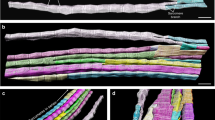Summary
The vertebrate myotendinous junction contains junctional microfibrils, located in the lamina lucida of the basement membrane. The junctional microfibrils are thought to transmit muscular force across the junctional lamina lucida, also called the connecting domain. If true, deformation of the terminal muscle cell processes and connecting domain during force transmission would be detected as a change in spacing and/or orientation of the junctional microfibrils. This study compared connecting domain morphology in frog semitendinosus muscles fixed in two extremes of resting tension, to elucidate the mechanical properties of the myotendinous junction. An initial study of connecting domain ultrastructure revealed that junctional microfibrils are punctate or spinelike in shape, and that they are distributed in a linear, helically-oriented array on the muscle cell surface. The rows in the surface lattice are 10–15 nm in thickness, have a centre-to-centre distance between rows of approximately 24 nm, and are oriented at approximately 41o with respect of the long axis of the muscle fibre. Comparison of slack and highly stretched myotendinous junctions shows no significant changes in spacing or orientation of either individual junctional microfibrils or rows in the helical surface lattice. Thus, both the connecting domain and terminal cell processes at the myotendinous junction are essentially inextensible under the loading conditions used in this study.
Similar content being viewed by others
References
Ajiri, T., Kimura, T., Ito, R. & Inokuchi, S. (1978) Microfibrils in the myotendon junctions. Acta Anat. 102, 433–9.
Bartels, H. (1986) Myomuscular junctions in the gill-sac muscle of the atlantic hagfish, Myxine glutinosa: analogy with myotendinous junctions. Cell Tissue Res. 246, 223–5.
Bartels, H. (1987) Intramembrane aspects of myotendinous and myomuscular junctions: a freeze-fracture study of the gill sac-muscle of the atlantic hagfish, Myxine glutinosa. Anat. Rec. 218, 249–55.
Bonilla, E. (1983) Ultrastructural study of the muscle cell surface. J. Ultrastruct. Res. 82, 341–5.
Byers, T. J., Kunkel, L. M. & Watkins, S. C. (1991) The subcellular distribution of dystrophin mouse skeletal, cardiac and smooth muscle. J. Cell Biol. 115, 411–21.
Draper, M. H. & Hodge, A. J. (1949) Studies on muscle with the electron microscope. 1. The ultrastructure of toad striated muscle. Austr. J. Exper. Biol. Med. Sci. 27, 465–503.
Eisenberg, B. R. & Milton, R. L. (1984) Muscle fiber termination at the tendon in the frog's sartorius: a stereological study. Am. J. Anat. 171, 273–84.
Gordon, A. M., Huxley, A. F. & Julian, F. J. (1966) Tension development in highly stretched vertebrate muscle fibres. J. Physiol. 184, 143–69.
Hanak, H. & Bock, P. (1971) Die feinstruktur der muskel-sehnen-verbindung von skelett- und herzmuskel. J. Ultrastruct. Res. 36, 68–85.
Horwitz, A., Dugan, K., Buck, C., Beckerle, M. C. & Burridge, K. (1986) Interaction of plasma membrane fibronectin receptor with talin—a transmembrane linkage. Nature 320, 531–3.
Huxley, A. F. & Peachey, L. D. (1961) The maximum length for contraction in vertebrate striated muscle. J. Physiol. 156, 150–65.
Ibraghimov-Beskrovnaya, O., Ervasti, J. M., Leveille, C. J., Slaughter, C. A., Sernett, S. W. & Campbell, K. P. (1992) Primary structure of dystrophin-associated glycoproteins linking dystrophin to the extracellular matrix. Nature 355, 696–702.
Ishikawa, H. (1965) The fine structure of myo-tendon junction in some mammalian skeletal muscles. Arch. Histol. Jap. 25, 275–96.
Korneliussen, H. (1973) Ultrastructure of myotendinous junctions in Myxine and rat: specializations between plasma membrane and the lamina densa. Z. Anat. Entwick.-Gesch. 142, 91–104.
Mackay, B., Harrop, T. J. & Muir, A. R. (1969) The fine structure of the muscle tendon junction in the rat. Acta Anat. 73, 588–604.
Magid, A. & Law, D. J. (1985) Myofibrils bear most of the resting tension in frog skeletal muscle. Science 230, 1280–2.
Mair, W. G. P. & Tomé, F. M. S. (1972) The ultrastructure of the adult and developing human myotendinous junction. Acta Neuropath. (Berlin). 21, 239–52.
Nakao, T. (1976) Some observations on the fine structure of the myotendinous junction in myotomal muscles of the tadpole tail. Cell Tissue Res. 166, 241–54.
Podolsky, R. J. (1964) The maximum sarcomere length for contraction of isolated myofibrils. J. Physiol. 170, 110–23.
Ramsey, R. W. & Street, S. F. (1940) The isometric length-tension diagram of isolated skeletal muscle fibers of the frog. J. Cell. Comp. Physiol. 15, 11–34.
Rapoport, S. I. (1972) Mechanical properties of the sarcolemma and myoplasm in frog muscle as a function of sarcomere length. J. Gen. Physiol. 59, 559–85.
Rapoport, S. I. (1973) The anisotropic elastic properties of the sarcolemma of the frog semitendinosus muscle fiber. Biophys. J. 13, 14–36.
Reedy, M. K., Goody, R. S., Hofmann, W. & Rosenbaum, G. (1983) Co-ordinated electron microscopy and X-ray studies of glycerinated insect flight muscle. I. X-ray diffraction monitoring during preparation for electron microscopy of muscle fibres fixed in rigor, in ATP and AMPPNP. J. Muscle Res. Cell Motil. 4, 25–53; 64.
Reedy, M. C., Reedy, M. K. & Tregear, R. T. (1988) Two attached non-rigor crossbridge forms in insect flight muscle. J. Mol. Biol. 204, 357–83.
Samitt, C. E. & Bonilla, E. (1990) Immunocytochemical study of dystrophin at the myotendinous junction. Muscle Nerve 13, 493–500.
Schmalbruch, H. (1974) The sarcolemma of skeletal muscle fibres as demonstrated by a replica technique. Cell Tissue Res. 150, 377–87.
Schwarzacher, H. G. (1960) Untersuchungen uber die skelet-muskel-sehnenverbindung. I. Elektronenmikroskopische und lichtmikroskopische untersuchungen uber den feinbau der muskelfaser-sehnenverbindung. Acta Anat. 40, 59–86.
Shear, C. R. & Bloch, R. J. (1985) Vinculin in subsarcolemmal densities in chicken skeletal muscle: localization and relationship to intracellular and extracellular structures. J. Cell Biol. 101, 240–56.
Shimizu, T., Matsumura, K., Sunada, Y. & Mannen, T. (1989) Dense immunostainings on both neuromuscular and myotendon junctions with an anti-dystrophin monoclonal antibody. Biomed. Res. 10, 405–409.
Small, J. V. (1968) Measurement of section thickness. In Proceedings of the 4th European Regional Conference (Rome) on Electron Microsocopy (edited by Bocciarelli, D. S.) pp. 609–10. Rome: Tipografia Poliglotta Vaticana.
Sten-Knudsen, O. (1953) Torsional elasticity of the isolated cross striated muscle fibre. Acta Physiol. Scand. 28 (Suppl.), 104.
Tidball, J. G. (1983) The geometry of actin filament-membrane associations can modify adhesive strength of the myotendinous junction. Cell Motil. 3, 439–47.
Tidball, J. G. (1984) Myotendinous junction: morphological changes and mechanical failure associated with muscle cell atrophy. Exp. Mol. Path. 40, 1–12.
Tidball, J. G. & Daniel, T. L. (1986) Myotendinous junctions of tonic muscle cells: structure and loading. Cell Tissue Res. 245, 315–22.
Tidball, J. G., O'Halloran, T. & Burridge, K. (1986) Talin at myotendinous junctions. J. Cell Biol. 103, 1465–72.
Trotter, J. A. & Baca, J. M. (1987) The muscle-tendon junctions of fast and slow fibres in the garter snake: ultrastructural and stereological analysis and comparison with other species. J. Muscle Res. Cell Motil.. 8, 517–26.
Trotter, J. A., Corbett, K. & Avner, B. P. (1981) Structure and function of the murine muscle-tendon junction. Anat. Rec. 201, 293–302.
Trotter, J. A., Eberhard, S. & Samora, A. (1983a) Structural domains of the muscle-tendon junction. 1. The internal lamina and the connecting domain. Anat. Rec. 207, 573–91.
Trotter, J. A., Eberhard, S. & Samora, A. (1983b) Structural connections of the muscle-tendon junction. Cell Motil. 3, 431–8.
Trotter, J. A., HSI, K., Samora, A. & Wofsy, C. (1985) A morphometric analysis of the muscle-tendon junction. anat. Rec. 213, 26–32.
Author information
Authors and Affiliations
Rights and permissions
About this article
Cite this article
Law, D.J. Ultrastructural comparison of slack and stretched myotendinous junctions, based on a three-dimensional model of the connecting domain. J Muscle Res Cell Motil 14, 401–411 (1993). https://doi.org/10.1007/BF00121291
Received:
Revised:
Accepted:
Issue Date:
DOI: https://doi.org/10.1007/BF00121291




